
Sea Surgeon's Dispensatory: 1 2 3 4 5 6 7 8 9 10 11 12 13 14 15 16 17 18 19 20 21 22 23 24 25 Next>>
The Sea Surgeon's Dispensatory, Page 21
Electuarium Diascordium
Listed in: Woodall-Chest: Diascordium1, Tweedy: Diascordium2
Category: Compound - Electuaries
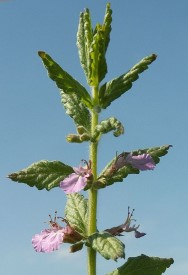
Photo: Wiki User Kenraiz
Scordium - Teucrium
Rx: "Take of Cinnamon, Cassia lignea, of each half an ounce, Scordium [water-germander] an ounce, Dittany of Creet, Tormentil, Bistort, Galbanum, Gum Arabick, of each half an ounce, Opium one dram and an half, Styrax Clamitis four drams and an half, Gentian leaf half an ounce, Bole armeniak an ounce and an half, Earth of Lemnos half an ounce, Long Pepper, Ginger, of each two drams; clarified Honey two pound and an half, Sugar of Roses one pound, Canary Wine ten ounces; make them into an Electuary according to Art."3
Description: "Diascordium is helpfull in fevers, as well contagious, as pestilentiall: good for the head-ach, and universall plague, whose dose is from halfe a dragme [dram] to one dragme and a halfe, according to the occasion or strength of the patient."4
"It is a well composed Electuary, something appreciated to the nature of Women, provokes the terms hastens their labour, helps their usual sickness at the time of their lying in [resting in bed after child birth]: I known nothing better. It stops fluxes [flows], mightily strengtheneth the heart & stomach, neither is it so hot, but it may safely be given to weak people, and besides provokes sleep. It may be safely given to young Children ten grains at a time; ancient people may take a dram or more. It is given as an excellent Cordial in such Fevers as are accompanied with want of sleep."5
1 John Woodall, the surgions mate, 1617, p. 86; 2 "158. John Tweedy's Bill for Medicines. November 8, 1743". Privateering and Piracy in the Colonial Period Illustrative Documents, John Franklin Jameson, ed., p. 458; 3 Nicholas Culpeper, Pharmacopœia Londinesis, 1720, p. 163; 4 Woodall, p. 86; 5 Culpeper, p. 163
Electuarium Diatrion Piperion
Listed in: Woodall-Chest: Diatrion Pipereon1
Category: Compound - Electuaries
Humoral Property: warme2
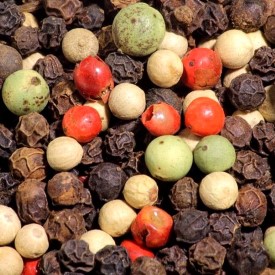
Photo: Wiki User Ragesoss
A Variety of Peppercorns
Rx: Take long pepper, black pepper and Jamaica pepper, of each six [French] ounces [a French ounce is slightly less than a normal apothecary's ounce] and fifteen grains; anise seeds, thyme and ginger roots, of each one [French] ounce.3
Walter Baily gives another prescription for this which included the titled three peppers - white, black and long - as well as ginger, thyme, aniseed and parsley seed.4
Johann Christoph Sommerhoff explained that, "Diatrion pipereon ...includes three kinds of Pepper: white, long and black."5
Description: "Diatrion Pipereon doth help the stomake, and is good for sower [sour] belching, quartans [malarial fevers occurring every three days], cold, and all flatious diseases, or wounds: of the species thereof you may {prescribe 1 dram} of hony {5 drams} put them together being well mixed, and keepe the same to give upon occasion to a weake stomake fasting, or at any time. It will warme and comfort him much: when men feele their stomackes oppressed with abstructions by reason of cold, now and then a little thereof given them will much comfort them, and preserve them well from fluxes of the belly."6
"...also the Electuary Diatrionpiperion given each morning a little on the point of a knife fasting, and last, namely at the party his going to bed, is a great preservative; for it doth warme and corroborate the stomacke, and preserveth from the Scurvy, and is very comfortable to bee given to any one that is diseased with the same, or subject thereto."7
1,2 John Woodall, the surgions mate, 1617, p. 83; 3 Denis Diderot & Jean le Rond d'Alembert, Encyclopédie, 1751, Vol. 4, p. 954; 4 Diatrion piperion", British History Online, gathered 7/28/14; 5 Johann Christoph Sommerhoff, Lexicon pharmaceutico-chymicum, latino-germanicum et germanico-latinum [Translated from Latin], p. 98; 6 Woodall, p. 83; 7 Woodall, p. 204
Electuarium Lenitivum
Listed in: Moyle: Electuarium Lenitivum1
Category: Compound - Electuaries
Humoral Property: hot & dry in the 3rd degree4; hot & dry in the 2nd or 3rd degree5; "hot in the first degree and drie in the third"6
Photo: Wiki User Mburnat - Dried Figs
Rx: "Take of dried Figs one Pound; and of the Leaves of Sena eight Ounces; the Pulps of Tamarinds, of Casia, and of French Prunes, of each half a Pound; of Coriander Seeds, four Ounces; of Liquorice three Ounces; of double refin'd Sugar, two Pounds and a half. Reduce the Sena with the Coriander Seed to Powder, and separate by the Sieve ten Ounces; boil the rest with the Figs and Liquorice in two Quarts of Water, till it is boiled half away, then strain and press it out; let the strained Liquor [liquid] be evaporated, to the Weight of a Pound and a half, or a little less; afterwards add the Sugar to make a Syrup; this Sugar mix gradually with the Pulps; and lastly stir in the Powder before separated by the Sieve."2
Description: "Given in Fevers without hurt. Dose to {2 ounces}."3
"This is the only officinal Lenitive Purge in use [by the Royal College of Physicians in London], and well enough answers that End, but it is a very unartful Composition; for what occasion is there for Prunes and Tamarinds in the Decoction, when they are afterwards added in Pulp? as likewise may the same be objected against the Sena; which as it cannot be well done without some Waste, the fibrous and stalky parts, which will not break and go through the Sieve, may be reserv'd for the Decoction; allowing somewhat more in quantity, as supposing them not so strong. ...Few boil this Medicine up high enough, which makes it fret and ferment, and sour in hot Weather; and then it gripes [causes pain of the stomach] and operates much rougher than is intended: it ought therefore to be of such a Consistence as will not stir by the greatest Heat, but keep its Form. This gently relaxes the Belly, and in costive [constipated] Habits, where such things are often wanted, it may rather be taken at any time to the quantity of a Nutmeg, than as a Cathartick [laxative]; but when it is so given, the Dose is from {2 drams to 1 ounce}."4
1 John Moyle, The Sea Chirurgeon, 1693, p. 31; 2 Robert James, Pharmacopoeia Universalis, 1747, p. 720; 3 Thomas Brugis, The Marrow of Physick, 1669, p. 106; 4 John Quincy, Pharmacopoeia Officinalis & Extemporanea, 1719, p. 405-6
Electuarium Rhubarb
Listed in: Woodall-Chest: Rhabarb: elect.1
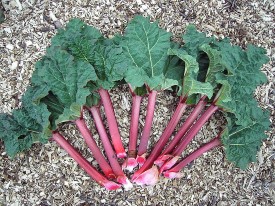
Photo: Dieter Weber - Rhubarb, Rheum Rhabarbarum
Category: Compound - Electuaries
Rx: "Powdered rhubarb, 1-1/2 dr[am]; sulphate of potassa [potassium sulfate], 1 dr[am]; cream of tartar, 4 dr[ams]; pulp of tamarinds, 2 oz. – Dose."2
Description: "Rhabarbarum or Ruberbe is hot in the first degree, and drie in the second, of an astringent nature, and is good for the stomake, and liver, and against the bloudy flixe [bloody flux], purgeth downward chollericke humors [yellow bile, one of the bodily humors], and therefore very profitably used against hot fevers, inflammations, and stoppings of the liver &c. {1 ounce} is the full dosse."3
1 John Woodall, the surgions mate, 1617, p. 94; 2 Arnold James Cooley, Cooley's Cyclopedia of Practical Recipts, p. 435; 3 Woodall, p. 94
Extractum Cassiæ pro Clysterbus
Listed in: Tweedy: Extract Cass. Fistul.1
Category: Compound - Electuaries
_fruits_J_M_Garg.jpg)
Photo: J.M. Garg - Cassia Fistula Pods
Rx: "'Take Leaves of Violets, Mallows, Mercury, Beer, Pellitory of the Wall, and Violet-Flowers, {of each one minim}. Make a strong Decoction with a sufficient quantity of Water, with which extract the Cassia [cassia fistula] from the Canes [pods], and boil it up to the Consistency of thick Syrup, and to every {1 pound} put {1-1/2 pounds} of red Sugar [Cyprus sugar].'"2
Description: "This is a good Laxative, if taken downwards [probably in the digestive system], as Circumstances may require such things; but it now is almost quite laid aside, both that way and for Clysters [enemas], that it is made but by very few. There are many other Extracts of Cassia, more or less opening [laxative]: but as they are Medicines not very grateful [pleasant] to take, by the Largeness of their Dose, and are ill enough to the sight, and likewise are subject to decay by fermenting and souring in the Shops; they are all almost quite rejected, and hardly ever order'd or made"3.
1 "158. John Tweedy's Bill for Medicines. November 8, 1743". Privateering and Piracy in the Colonial Period Illustrative Documents, John Franklin Jameson, ed., p. 459; 2,3 John Quincy, Pharmacopoeia Officinalis & Extemporanea, 1719, p. 405
Extractum Catholicon
Listed in: Woodall: Extract. Catholicon purgans.1
Category: Compound - Electuaries
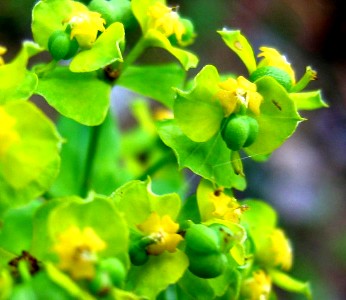
Photo: Kristian Peters - Euphorbia Esula - Leafy Spurge
Rx: "Take fine Aloes {1/2 pound} Rhubarb {5 ounces} Sena {4 ounces} Mechoacan [Convolvulus Michoacan] {2 ounces} Colquintida [Citrullus colocynthis] {1 ounce} Turbith {2.5 ounces} Esula [Euphorbia Esula - leafy spurge] prepared {1/2 [ounce?]} of the five Myrobalans. {of each 2 drams} Cinnamon, Ginger, Mace, Galangal, Zedoary [white tumeric], Cloves, Cardamoms, Citron Peels, Schænanth [Juncus odoratus], {of each 1 dram} Diambræ [a powder composed of spices] {2 drams} Diarhodon [Electuary of Red Roses] {3 drams} make an Extract with S.V. [Spritus Vini] and Fennel Water, strain and inspissate [allow to congeal]."2
Description: "This extract is a Laxative medicine (being drawn form the most excellent of vegetable laxative ingredients) fitting to be ever ready at hand in a Surgeons Chest, or else where in Surgery. The dose is small, namely 15. Grains at the most: the taste pleasant, not nauseous nor bitter at all; neither causing tortions [pains], nor gripings in the bowels: It is a medicine that will keepe good for seven yeeres without putrefaction, the vertues whereof have been by the Author (for many yeeres well experienced) both at Sea and Land approved of."3
"It purges Choler [yellow bile, one of the bodily humors] and Flegm [phlegm, another bodily humor], cures the Jaundices and Kings Evil [scrofula], and opens Obstructions of the Stomach and Bowels. It is a very safe Purge. Dose {1 dram}."4
1 John Woodall, the surgions mate, 1639, p. 56; 2 William Saltmon, Pharmacopoeia Londinensis, 1716, p. 475; 3 Woodall, p. 56; 4 Saltmon, p. 475
Mithridatum
Listed in: Woodall-Chest: Methridatum Damocratis.1, Moyle: Mitheridatum2
Category: Compound - Electuaries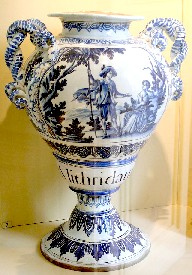
Photo: R. Valette
Mithridate Apothecary Jar, from
Musee
de la Science a Marseille (1685-1690)
Rx: " Take of Myrrh, Saffron, Agarick, Ginger, Cinnamon, Spicknard, Frankincense, Treacle, Mustard seeds, of each ten drams, the seeds of Hartwort [Tordylium apulum], Opabalsamum, or Oyle of Nutmegs by expression, Scænanth [Cymbopogon schoenanthus], Stechas [lavender],
Costus, Galbanum, Turpentine, long Pepper, Castorum, juices of Hypocistis, Styrax, Calamitis, Oppopanax, Indian leaf [curry leaf], or for want of it Mace, of each an ounce; Cassia lignea, Poley mountain [Teucrium montanum - a type of germander], white Pepper, Scordium [water-germander], the seeds of Carrots of Creet, Carpobalsamum of Cubebs, Troch, Cypheds, Bdellium, of each 7 drams, Celtick, Spicknard, Gum Arabick, Macedonian Parsley seeds, Opium, Cardamoms the less, Fennel seed, Gentian, red Rose leaves, Dittany of Creet, of each five drams; Aniseed, Asarabacca [Europe wild ginger], Orris [iris], Acorus, the greater Valerian, Sagapen, of each 3 drams; Meum Acacia, the bellies of Scinks [lacerta longicauda – fringe-toed lizard], the tops of St. Johns wort, of each two drams and an half; Malaga Wine so much as is sufficient to dissolve the juices and Gums, clarified Honey the treble weight of all, the wine excepted; make them into an Electuary according to Art."2
Description: "Methridate
Photo: Wiki User Boazschacham
Fringe-Toed Lizard - Macanthodactylus Scutellatus of Damocrates is in quallity and vertue like to Treakell [treacle], but more hotter and forcible against the poison of Serpents, madde Dogs, wilde Beasts, creeping things, being used as a plaster, or drunke, it cureth all the cold affections of the head, helpeth the melancholick or those that are fearefull of waters, them also that have the falling sicknesse [epilepsy], Megram [migraine], paine in the bowels, eares, tooth ach, and weeping eies, healeth the evills of the mouth and jawes, being plasterwise laide to the temples by discussion [scattering] giveth ease to the troubled with the Squincy [throat problems], Apoplexie [unconsciousness, caused by hemorrhage or stroke], cough, spitting of bloud, Impostumes [large abscesses], or inflammations of the lungs, or any griefes within the body, and is good against the bloudy flixe [bloody flux], fluxe of the stomake, obstruction of the guts, and against ringing and tortions [pains] in them, being take with aqua vitæ [brandy] and the decoction of baulastians [pomegranates], it remedieth convulsions and palsie, helpeth the middriffe flatus [irritable bowel syndrome], Hipocondria, the paines of the reines [kidneys], & bladder, breaketh the [bladder] stone, provoketh urine and monthly flowes, expelleth other vices of the matrix [womb], yeeldeth a singular benefit for the Goute, profitteth not a little in quotidians [daily recurring fevers], and quartanes [fevers recurring every third day], a quantity drunke in wine, being first warmed, and then taken an houre before the fit."3
1 John Woodall, the surgions mate, 1617, p. 84; 2 John Moyle, The Sea Chirurgeon, 1693, p. 31; 3 Woodall, p. 84-5
Philonium Persicum (Peppered Opium)
Listed in: Woodall: Philonium Persicum1
Category: Compound - Electuaries
Photo: Wiki User Ra'ike - Bloodstone (Heliotrope)
Rx: "'Take white Pepper, Seeds of white Henbane, {of each 2-1/2 ounces} Opium, Earth of Lemnos, {of each 10 drams}. Blood-Stone [heliotrope], Saffron, {of each 5 drams}. Castor, Spikenard, Pellitory of Spain, Pearls, Amber, Zedoary [white tumeric], Elicampane, Troches of Rhamich, {mix 1 dram}. Camphire {1 scruple}. Honey of Roses, three times the quantity of the whole. Make into an Electuary.'"2
Description: "Philonium Persicum is invented against the abundance of bloud [referring here to blood as one of the bodily humors], of womens monethly termes [menstruation], of the hemorrhoids, and for the over-much flux of their courses, the flux of the belly, against vomiting and spitting of bloud: it doth also consolidate ulcers and veynes."3
Woodall refers back to to this medicine in his discussion of Aurea Alexandrina, advising that it not be included in the chest since it "will not keepe an East India voyage, and Laudanum opiate paracelsi is sufficient for ought [anything] the other can doe."4
"This is one of the warmest Compositions of an Opiate that we meet with, and is too much of a Piperine [pepperish] kind for an Alexipharmick [medicine used to treat poisoning]; but it is good in some kind of Cholicks for tough and phlegmy Humours [phlegm is one of the bodily humors], tho' in bilious Cholicks the contrary: it is of use to break any Wind in flatulent cold Stomach and procures immediate ease almost in all Pains. It may be given from 10 grains to 1 dram, or 4 scruples for a Dose. In the last quantity there is just {2-1/2 grains} of Opium, and {5 grains} of the Henbane-Seed, which is as much as is safe to give at a time of those things to any Person. This is not often prescrib'd, nor frequently in the [apothecary] Shops."5
1 John Woodall, the surgions mate, 1617, p. 87; 2 John Quincy, Pharmacopoeia Officinalis & Extemporanea, 1719, p. 408; 3 Woodall, p. 87; 4 Woodall, p. 88; 5 Quincy, p. 408
Philonium Romanum (Spiced Opium)
Listed in: Woodall: Philonium Romanum1, Tweedy: Philon. Roman.2
Category: Compound - Electuaries
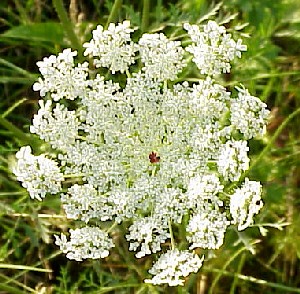
Photo: Kurt Stüber - Daucus Carota (Queen Anne's Lace)
Rx: "'Take white Pepper, Seeds of white Henbane, {of each 5 drams} Opium {2-1/2 drams} Cassia-Bark {1-1/2 drams} smallage-seed [wild celery] {1 dram} Seeds of Parsly, Fennel, and Daucus [probably wild carrot or Queen Anne's lace], {of each 14 grains}. Saffron {1/2 dram} Spikenard, Pellitory of Spain, and Zedoary [white tumeric], {of each 15 grains}. Cinnamon {1-1/2 drams}. Myrrh and Castor, {mix 1 dram}. Honey, three times the quantity of the whole. Mix them, S. A. [according to Art].'"3
Description: "Philonium Rom: Magnum is given for the Pleurisie [tuberculosis], Collicke, and any internall paine or griefe: it causeth sleepe: stayeth Hemoragia or the flux of bloud in the inward parts and sneesing: allayeth the greese of the belly, spleene, liver, and reynes [kidneys] caused by cold, winde, and crude humours: and taketh away the hicket [hiccups]: the quantitie of {1 scruple} is the usuall dose, and it is augmented or decreased as the yeares and strength of the Patient is."4
Woodall refers back to to this medicine in his discussion of Aurea Alexandrina, advising that it not be included in the chest since it "will not keepe an East India voyage, and Laudanum opiate paracelsi is sufficient for ought [anything] the other can doe."5
"This is somewhat more us'd than the former [Philonium Persicum], but their Difference is not great. The proportion of Opium and Henbane is the same in both, and therefore their Doses also alike. [It may be given from 10 grains to 1 dram, or 4 scruples for a Dose.]"6
1 John Woodall, the surgions mate, 1617, p. 87; 2 "158. John Tweedy's Bill for Medicines. November 8, 1743". Privateering and Piracy in the Colonial Period Illustrative Documents, John Franklin Jameson, ed., p. 458; 3 John Quincy, Pharmacopoeia Officinalis & Extemporanea, 1719, p. 408; 4 Woodall, p. 87; 5 Woodall, p. 88; 6 Quincy, p. 408
Philonium Tarsense Galeni (Turkish Opium)
Listed in: Woodall: Philonium Romanum1
Category: Compound - Electuaries

Photo: Kurt Stüber - Daucus Carota (Queen Anne's Lace)
Rx: "'Croci [saffron] {5 drams}, Pyrethri [Pyrethrum, or pellitory], Euphorbil {Euphorbium],
Nardi Indicæ [Indian nard] {of each one dram}, Piperis albi [white pepper], Sem. Hyoscyami [Seeds of Henbane] {of each twenty-one drams}, Opii [opium] {10 drams}, Mellis [Honey] {three times as much}, Consice secumdum artem [make according to Art].'"2
Description: "Pholonium Tarsense is of the same facultie as Philonium Romanum."3
Of philonium romanarum, Woodall says it "is given for the Pleurisie [tuberculosis], Collicke, and any internall paine or griefe: it causeth sleepe: stayeth Hemoragia or the flux of bloud in the inward parts and sneesing: allayeth the greese of the belly, spleene, liver, and reynes [kidneys] caused by cold, winde, and crude humours: and taketh away the hicket [hiccups]: the quantitie of {1 scruple} is the usuall dose, and it is augmented or decreased as the yeares and strength of the Patient is."4
Woodall refers back to to this medicine in his discussion of Aurea Alexandrina, advising that it not be included in the chest since it "will not keepe an East India voyage, and Laudanum opiate paracelsi is sufficient for ought [anything] the other can doe."5
1 John Woodall, the surgions mate, 1617, p. 87; 2 Johann Zwelfer, Pharmacopoeia Augustana reformata, p. 462-3, Translated out of Latin by the author; 3,4 Woodall, p. 87; 5 Woodall, p. 88; 5 Quincy, p. 408
Theriaca Andromachi (Venice Treacle)
Listed in: Woodall-Chest: Theriacha Andromachi.1, Moyle: Thriac. Andromic2, Tweedy: Theriac. Andromach3
Category: Compound - Electuaries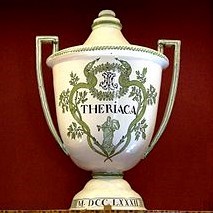
Photo: Wiki User Jebulon
An Apothecary's Theriac Jar From
Hospices de Beaune
Rx: "Take of Troches of Quills forty eight drams; Troches of Vipers, long Pepper, Opium of Thebes, Magma [a salve, or thick paste], [Troches of] Hedycroi dried, of each 24 drams: dried red Roses exungulated [pared off - probably having the petals removed from the flower and used], Orris [iris], Illyrick [Illyrian thistle], juice of Liquorice, the seeds of sweet Navew [French turnip], Scordium [water-germander], Opobalsamum; Cinamon, Agarick, or each 12 drams; Myrrh, Costus or Zedoary [white tumeric], Saffron, Cassi Ligna, Indian Spicknard, Schænanth [Cymbopogon schoenanthus], Pepper white and black, Olibanum [frankincense], Dittany of Creet, Rhapontick, Stœchas [lavender], Horehound, Macedonian Parsley seed, Calaminth [Storax calamintha], Cypress, Turpentine, the roots of Cinquefoyl and Ginger, of each six drams; Poley mountain [Teucrium montanum - a type of germander], Chomepytis [Ajuga chamaepitys], Coltick, Spicknard, Amomus [amomum - an Indian spice plant], Styrax, Calamitis, the Roots of Rhavontick [Rhapontic - a type of thistle], Earth of Lemnos, Indian leaf [curry], Calcitis [vitriol] burnt; or instead thereof Roman Vitriol burnt, Gentian roots, Gum Arabick, the juice of Hypocistis [Cytinus hypocistis], Carpobalsamum, or Nutmegs or Cubebs, the seed of Anise, Cardamoms, Fennel, Hartwort, Acacia [sloes], or instead thereof the juice of Sloes made thick, the seeds of Treacle, Mustard and Ammi [Ammi Major - bishop's flower], the tops of St. Johns wort, Sagapen, of each four drams, Castoreum the root of long Bithwort, Bitumen, Judaicum, Carrot seed, Opopanax,
Chomepytis - Ajuga Chamaepitys
Centaury the less, Galbanum, of each two drams Canary Wine enough to dissolve, Honey the treble weight of the dry species: make them into an Electuary according to Art."5
Description: Woodall prescribes Venice Treacle when "you fear venemous vapours [and as] a good Alexiphramacon or Preservative against poyson"6 . He also advises that "Venice Treakle, Mithridate, and London Treakle preserve well from this disease daily taken fasting" in his discussion on scurvy.7 He suggests its use in Fluxes, explaining "I hold it the safest course to for beare bleeding or purging, for feare of drawing backe the venome to the principall parts, and rather to flie to Alexipharmacons or Preservatives, as Venice Treakell, Mithridate, Diatesseron, London Treakell, or the like"8. He also calls it a "Present Cordiall medicine fitting to be given in the Callenture [feverish delirum of the tropics] ...in cordial water.9
1 John Woodall, the surgions mate, 1617, p. 85; 2 John Moyle, The Sea Chirurgeon, 1693, p. 31; 3 "158. John Tweedy's Bill for Medicines. November 8, 1743". Privateering and Piracy in the Colonial Period Illustrative Documents, John Franklin Jameson, ed., p. 458; 5 Nicholas Culpeper, Pharmacopœia Londinesis, 1720, p. 166; 6 Woodall, p. 141; 7 Woodall, p. 186-7; 8 Woodall, p. 211-2; 9 Woodall, p. 248
Theriaca Diatesseron (Greek Treacle)
Listed in: Woodall-Chest: Theriaca Diatesseron Mesais1
Category: Compound - Electuaries
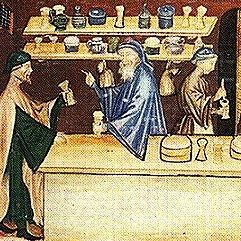
Theriac Preparation, From Tacuinum
sanitatis (14th c.)
Rx: "Take of Gentian Root, Bay-Berries, Myrrh, and round Birth-wort, each two Ounces; of Honey two Pounds; mix them into an Electuary. This with the addition of the Shavings of Ivory, two Ounces, is instituted Diapente, or a Composition of five Ingredients. This hath passed without Alterations, through all the Emendations [revisions or corrections] of the College Dispensatories, where at first it entered under the title of a Theriaca. It comes originally from Mesue [8th/9th Assyrian physician Yuhanna ibn Masawaih]; Avicen [Avicenna - 10th century Persian physician] also prescribes it; but it is hardly ever ordered in the Form of an Electuary, and therefore not kept so in [apothecary] Shops".2
Uses: "The vertues of Diatesseron are said to be as followeth. It is good against poyson drunken, and against the bitings of venomous beasts or wormes. It is also good against all the cold effects of the braine, as convulsions, resolutions of the sinowes, morbum Comitialem [epilepsy], the Spasme or Crampe, the inflation of the ventricle or stomacke against the defect of concoction [digestion] therein: and against venomous wounds bothe inwardly drunke, and outwardly applied. Also it openeth the obstructions of the liver and spleene, thereby preserveth the body from the disease called Cachexia or stomacace, which is the Scurvy."3
1 John Woodall, the surgions mate, 1617, p. 85; 2 John Quincy, The Dispensatory of the Royal College of Physicians in London, 1727, p. 99; 3 Woodall, p. 86
Theriaca Londinensis (London Treacle)
Listed in: Woodall-Chest: Theriaca Londini1, Moyle: Thriac. Lond.2
Category: Compound - Electuaries

Photo: Wiki User Jebulon
Apothecary's Theriac Jar, From the
Hospices de Beaune, circa 1782
Rx: "Take of Harts-horn two ounce; the seeds of Citrons, Sorrel, Peony, Bazil. [bazilicum] of each one ounce; Scordium [water-germander], Coralliana, of each six drams, the Roots of Angelica, Tormentil, Peony, the leaves of Dittany, Bay berries, Juniper berries, of each half an ounce, the flowers of Rosemary, Marigolds, Clovegilliflowers [probably Clove Pink Dianthus caryophyllu], the tops of St. Johns wort, Nutmegs, Saffron, or each three drams, the roots of Gentian, Zedoary [white tumeric], Ginger, Mace, Myrrh, the leaves of Scabious, Devils bit [Succisa pratensis], Carduus, of each 2 drams, Cloves, Opium, of each 1 dram; Malaga Wine as much as is sufficient, with their treble weight in Honey, mix them according to Art."3
Woodall provides an interesting way to compose London Treacle specific to sea surgeons. "I have appointed to the Surgeons chest some of the Species [ingredients] of the London treakell ready poudered, and dry, that the diligent Surgeon at his will may compose a London
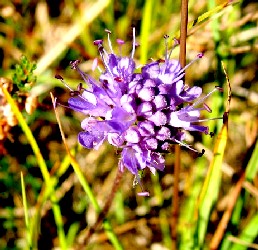
Photo: Kristian Peters
Devil's Bit - Succisa Pratensis
Treakell at sea, namely, by taking hony {3 drams}, and of this pouder {1 dram}, and heate them together, stirring them well till all be incorporated, and give it as neede shall require."4
Description: "This composition was heretofore appointed by the wisedome of the learned and grave Doctors of the Phisitions Colledge in London, as a thing very requisite, for that the price should be reasonable for the poorer sort, and yet such as are in London at all times to be had, it may be used well in place of Mithridate..."5 Woodall explains that MIthridate is an overly complex recipe made "in Holland" where he finds they cheat on the recipe and don't make it properly. (Apparently the London apothecaries are beyond reproach in his mind.)
Nicholas Culpeper says of London Treacle, "The Reciept is pretty Cordial, resist the Pestilence, and is a good Antidote in Pestilential times, it resists poyson strengthens cold stomach, helps digestion, crudities, of the stomach. A man may safely take two drams of it in a morning, and let him fear no harm."6
1 John Woodall, the surgions mate, 1617, p. 83; 2 John Moyle, The Sea Chirurgeon, 1693, p. 31; 3 Nicholas Culpeper, Pharmacopœia Londinesis, 1720, p. 167; 4 Woodall, p. 84; 5 Woodall, p. 83; 6 Culpeper, p. 83
Pills and Troches
Pills and Troches (what we would call lozenges - like cough drops) are among the more readily recognizable forms to us today. Nicholas Culpeper explains that making pills is "very easie, for with the help of a Pestle and Motar, and a little diligence, you may make any Powder into Pills, either with Syrup, or ...Jelly"1. Troches are made "with Gum Tragicanth, put it into a Galli-pot, and put half a quarter of a pint of any distilled Water fitting... cover it, and the next Morning you shall find it in such jelly as Physicians call Mussilage [mucilage]; with this you
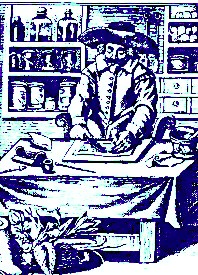
Apothecary Making Medicines, From
The Workes of That Famous Chirurgeon
Ambrose Parey (1649)
may (with a little pains taking) make any Powder into past[e], and that past[e] into little Cakes called Troches."2 These were then dried 'in the shadow' and kept in a pot.
Apothecary John Quincy explains, "The main Design of this Form [in ancient times] seems to have been to preserve in readiness for present Use, Substances which stood in need of some Preparation, and took up time to reduce into Powder, and which by lying in dry Powder would likewise be subject to decay sooner than in this form."2 Culpeper notes the same thing of troches, explaining that medicines made up in this form "might resist the intromission of Air, and so endure pure the longer."3 This reasoning makes them sound like an ideal method for preserving medicines taken to sea, yet there are only 15 of them included in the various sea surgeon's recommendations under study.
Culpeper suggests another reason for using pills to deliver medicines, they were "invented only to decieve the palate, that so by swallowing them down whole, the bitterness of the Medicine might not be perceived, or at least it might not be be unsufferable"4. He suggests a third reason, medicines "were done up in this hard form [as pills], that so they might be the longer in digesting... If the infirmitie lie in the head or any other remote part, the best way is to use Pils, because they are longer in digestion, and therefore the better able to call the offending humor to them."5
1 Nicholas Culpeper, The English Physition, 1655, p. 284; 2 Culpeper,p. 283;3 John Quincy, Pharmacopoeia Officinalis & Extemporanea, 1719, p. 415-6; 4,5 Culpeper,p. 283
Laudanum Paracelsi Opiatum
Listed in: Woodall-Chest: Laudanum Paracelsi Opiatum1, Moyle: Piluilæ Laudanum2
Category: Compound - Pills and Troches
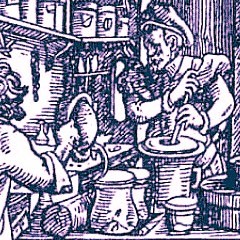
An Apothecary Making a Medicine, From
Das Standebuch,
by Jost Amman (1586)
Rx: "This is one of the few recipes Woodall recites in his text in full. Note that this is the recipe for the Laudanum pill. The brown liquid most people think of when they think of laudanum was first set down in print by physician by Thomas Sydenham decades later.
As was tradition at this time, Woodall gives most of the recipe in Latin.
"Rx. Opii Thebaici uncias tres. [Thebiac Opium three ounces]
Succi Hyoscyami debito tempore collecti, & in Sole prius inspissati unciam unam & sem specierum Diambræ & Diamosschi, fideliter dispensatarum ana uncias duaes cum dimidio mummiæ transmarinae & selectæ unciam sem. [Henbane juice collected in due time, and in the sun before it congeals, one ounce and a half, of species Diambræ (a powder composed of spices) and Diamosschi (a preparation of musk) honestly dispensed, two and a half ounces; Of selected Egyptian mummy an ounce and a half.]
Salis perlarum.
Gorallorum ana {3 drams} [salt pearls and coral, 3 drams]
Photo: Den Haag
Poppy Sliced to Harvest Opium
Liquoris Succini Albi per Alcohol Vini extracti. [extract in Spirit of Wine]
Ossis de corde Cervi ana drachmam j. [Bone from the heart of a deer, 1 dram)
Lapidis Bezoartici. [Bezoar Stone]
Unicorni animalis vel mineralis {1 dram} [Shavings of a unicorn horn, 1 dram]
Moschi.
Ambrae ana {one scruple} [Deer Musk & Amber, one scruple]
In defectu genuini auri potabilis nullis corrosivis inquinati addantur,
[In absence of genuine liquid gold without corrosive, we add Oil of]
Oleorum Anisi. [Oil of Anise]
Carui.[Oil of Caraway]
Arantiorum. [Oil of Orange]
Citrorum. [Oil of Citron]
Nutistæ.
Cariophyllorum. [oil of cloves]
Cinamomi. [oil of cinnamon]
Succini [oil of amber] ana guttæ 12. [of each 12 drops]
Fiat ex his secundum artem Chymicam, massa, seu extractum, ex quo ad necessarios usus, possint pillulae efformari. [Let it be made into pills from the chemical mass or extract to be used when needed according to the art.]"3
Description: While he goes to a lot of trouble to give the recipe, Woodall has little to say about its use. "In the treatise of fluxes of the belly, it is handled at large, to which I refer the friendly Reader."4 Notably missing are the pain-killing and soporific operations of the drug.
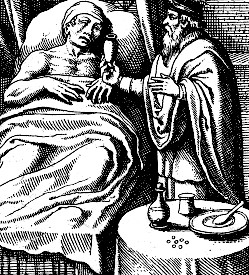
Administering Medicine, From De Efficaci
Medicina Libri Tres, By Marco Aurelio
Severino, Title Page (1646)
Thomas Brugis lists a great many other uses of the laudanum pill, often mixing it with liquids. He begins first with a warning.
"Note. Never administer any Narcotics, before you have tryed Anodines [medicine to combat poisoning]....
In fine, according to divers intentions these Narcotics are to be used, so you must give them at different times; i.e. you must give them at night to cause sleep; in the morning to appease pain, and stop immoderate evacuations, as the hemoragie, and hemorrhoids, &c. four hours before or after supper, to incrassate [thicken] humors in fluxions [flows] when too thin....
In all sharp pains whatsoever, hot or cold, within or without the body; yea even when through extremity of pain the parties are at deaths door, or almost mad with the vehemency of the same, this Medicine giveth ease presently, yea, and quiet sleep, and that safely, but much better the body being first soluble [opened] either by nature or art; I mean by a suppository, or clyster [enema], which is better."5
He continues at great length, suggesting laudanum pills for colic, kidney problems, pleurisy, joint pain, colds and tooth aches ("...in the Tooth-ach, dissolve four grains thereof in Plantain water, and put it into the Ear of the aching side, and take three grains into the body, and lie to rest."6), diarrheas and related problems, extreme insomnia, extreme nosebleeds, all kinds of fevers ("in burning Fevers it assuageth thirst, and provoketh sleep"7), asthmas, coughing, the bloody flux, 'frensies and madness' and epilpesie.8
1 John Woodall, the surgions mate, 1617, p. 86; 2 John Moyle, The Sea Chirurgeon, 1693, p. 31; 3 Woodall, p. 229; 4 Woodall, p. 86; 5 Thomas Brugis, The Marrow of Physick, 1669, p. 120; 6 Brugis, p. 121; 7 Brugis, p. 122; 8 Brugis, p. 121-3
Pilulæ Agregativæ
Listed in: Woodall-Chest: Pilulæ Aggregatine1
Category: Compound - Pills and Troches
Photo: Michael Maggs
Agaric Mushroom -
Amanita Muscaria
Rx: ""Take of Citron Mirobalans, Rhubarb, of each half an ounce; Juyce of Agrimony and Wormwood made thick, of each 2 drams;
Diagridium [scammony] 5 drams, Agarick, Colocynthis [Citrullus colocynthis], Polypodium, of each two drams; Turbith [Operculina turpethum], Aloes, of each six drams: Mastich, red Rose, Sal. Gem. [Sal Gemmae - rock salt], Epithimum, Annis, Ginger, of each a dram, with Syrup of Damask Roses, make it into a Mass according to Art."2
Description: "Pilula Aggregatinæ, so called either from the Agaricum or the aggregation of many vertues that are said to be therin: for they are profitable for many affections of the head, stomacke, and liver: they purge phleame [phlegm, one of the bodily humors], choler [yellow bile, another bodily humor], and melancholy [black bile, a bodily humor]; and therefore are of very good use against continuall fevers, and inveterate diseases, and are described by Mesues [8th/9th Assyrian physician Yuhanna ibn Masawaih], whose dose if from two scruples to a dragme [dram] and a halfe. But beware of the use of these pills, where the flux raigneth [rages]; for Agaricum in such bodies dies as are incident thereto is a dangerous medicine. I speake this of practise, wherefore remember it."3
1 John Woodall, the surgions mate, 1617, p. 89; 2 Nicholas Culpeper, Pharmacopœia Londinesis, 1720, p. 180-1; 3 Woodall, p. 89-90
Pilulæ Aurae (Golden Pill)
Listed in: Woodall-Chest: Pilulæ Aureæ1
Category: Compound - Pills and Troches
Photo: Wiki User Alamout - Saffron Flowers
Rx: "Take of Aloes, Diagrydium [scammony], of each five drams; red Roses, Smallage seeds of each two drams and an half; the seeds of Anise and Fennel, of each one dram and an half; Mastich [mastic], Saffron, Troch. Alhandal, of each one dram; with a sufficient quantity of Honey of Roses, make it into a Mass according to Art."2
Description: "Pilulæ Auræ, or the golden pill, being in colour like aurum or golde, because of the saffron in him, they are cholagogall, attracting choler [yellow bile, one of the bodily humors], yea, and flegme [phlegm - another humor] too, from the inferiour and superior venter [muscles in the neck]: and therefore purgeth the head, senses and eyes, & restoreth the eye-sight: they were first made knowen by Nicholaus Myrepusus, who was the first Authour of them; their dose is like that of the pils Aggregative. {2 scruples to a dram and a half}"3
"They are held to purge the Head, to quicken the Senses, especially the sight, and to expel wind from the Bowels, but work something harshly. Half a dram is the utmost Dose: keep the fire, take them in the morning, & sleep after them, they will work before noon."4
1 John Woodall, the surgions mate, 1617, p. 90; 2 Nicholas Culpeper, Pharmacopœia Londinesis, 1720, p. 182; 3 Woodall, p. 90; 4 Culpeper, p. 182
Pilulæ Balsamicae Anodyne
Listed in: Moyle: Piluilæ Balsamica1
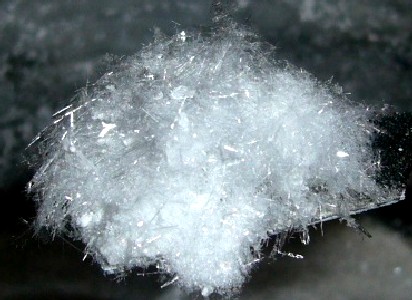
Photo: Wiki User Norsci - Benzoic Acid Crystals
Category: Compound - Pills and Troches
Rx: "'Take Liver of Sulphur [potassium sulfide] {4 ounces} Balsam of Tolu [resin of the tree Myroxylon toluiferum] {2 ounces} Flowers of Benjamin [Benzoic acid] {2 drams} Salt of Tartar and Opium {of each 1/2 ounce} Spirit of Turpentine a sufficient quantity to make a Mass.'"2
Description: "This is a most useful Composition, and is preferable to any other of this Intention, as it is a good Balsamick without being too agglutinating, and is a good Detergent [cleanser] without any Irritation; and therefore may be safely given in all Coughs, and to all Constitutions. The Dose is from {5 grains to 1 scruple} or more."3
1 John Moyle, The Sea Chirurgeon, 1693, p. 31; 2,3 John Quincy, Pharmacopoeia Officinalis & Extemporanea, 1719, p. 427
Pilulae Cambogiae
Listed in: Woodall-Chest: Pilulæ Cambogiæ.1
Category: Compound - Pills and Troches
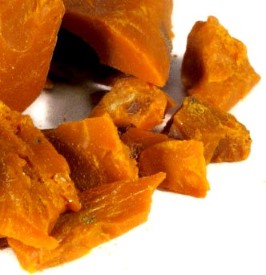
Gamboge Resin
Rx: "Take {1 scruple} in powder of gamboges, {1.5 scruples} in powder of extract of spiked aloes, {1/2 scruple} of powdered ginger, {2 scruples} of hard soap; mix the powders together, then having added the soap, beat the whole together till incorporated, and divide into five grain pills."2
Description: "Pilulæ Cambogi, are good to clense the head and refresh the sight, to purge coller [yellow bile, a bodily humor], fleame [phlegm, another bodily humor] or melancholy [black bile, a humor] from the stomacke or spleene, they open obstructions, and thereby profit well in the cure of the dropsie and scurvy, and for the cure of Icteritiæ flaræ, or the yellow jaundice they are very good, this Cambogiæ is much used in Holland and Germany, and Dr. Harvey of St. Bartholomews Hospitall [English Physician William Harvey], calleth it purging saffron, and giveth it in pils per se, in which manner given, it purgeth both wayes [causes vomiting and works as a laxative] forcibly, but the pils here mentioned, purge onely downewards [work as a laxative] very gently, their dose is {1/2 dram}."3
1 John Woodall, the surgions mate, 1617, p. 91; 2 James Rennie, A New Supplement to the Pharmacopœpias of London, Edinburgh, Dublin and Paris, Baldwin and Cradock, 1833, p. 319; 3 Woodall, p. 91
Pilulæ Cochiæ
Listed in: Woodall-Chest: Pilulæ Cochiæ1, Moyle:Pilulæ Cochiæ2
Category: Compound - Pills and Troches
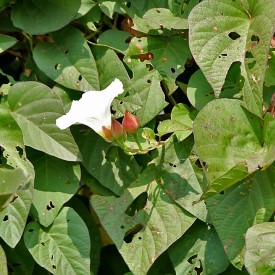
Photo: J.M. Garg - Turbith (Operculina Turpethum)
Rx: "Take of Species and Heira Picra [a cathartic powder of aloes and canella bark] ten drams. Troch Arhandal [Trochisci Alhandal, a compound lozenge] three drams and an half, Turbith [Operculina turpethum], Stæchas [probably Lavandula stoechas], of each five drams; with sufficient quantity of Syrup of Stæchas, make it into a Mass according to Art."3
Description: "Pilulæ Cochiæ deriving the name from a Greeke word nonnos, a graine (pils being formed small and round like graines of Cicers [chickpeas]) doth purge both choler [yellow bile, a bodily humor] and fleame [phlegm, another bodily humor] from the head, the liver, and from all other parts, wherein such humours are contained, and are found described, first by Dr. Rahsis [Persian physician Muhammad ibn Zakariya al-Razi], who is their supposed Authour. The dose is divers, as before, sometimes great, somtimes small, but {1 dram} is the ordinary dose."4
1 John Woodall, the surgions mate, 1617, p. 90; 2 John Moyle, The Sea Chirurgeon, 1693, p. 31; 3 Nicholas Culpeper, Pharmacopœia Londinesis, 1720, p. 182; 4 Woodall, p. 90
Pilulæ Euphorbium
Listed in: Woodall-Chest: Pilulæ de Euphoribio.1
Category: Compound - Pills and Troches
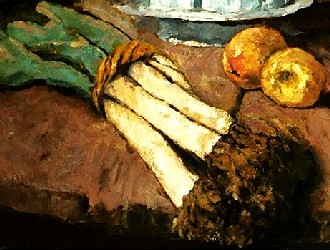
Artist: Carl Scuch - Leeks
Rx: "'Take Euphorbium, Colocynth [Citrullus colocynthis], Agarick, Bdellium, Sagapenum [A yellow-brown bitter gum derived from Ferula plants], {of each 2 scruples) Aloes {5 scruples}. Make them into a Mass with Juice of Leeks.'"2
Description: "Pilulæ de Euphoribio, pils of Euphorbium, receiving Musues [Physician Yuhanna ibn Masawaih] as their Patron, are virtuous against the dropsie [edemas] and Scurvy, for they calefie [warm] the stomacke and entrails, purge water abundantly, prevaile also in removing the cause of tumours, and bring ayde for the paine of the loynes [loins] and gowt [gout], proceeding from too much humidity: they are effectuall in the quantity of one scruple, or halfe a dragme [dram], and may be mixed with Pilulæ Cochiæ."3
1 John Woodall, the surgions mate, 1617, p. 90; 2 John Quincy, Pharmacopoeia Officinalis & Extemporanea, 1719, p. 426-7; 3 Woodall, p. 90
Pilulæ ex Duobus
Listed in: Moyle: Piluilæ Ex dubus1
Category: Compound - Pills and Troches
Photo: H. Zell - Citrullus colocythis
Rx: "'Take Colocynth [Citrullus colocynthis] and Scammony, {of each 1 ounce}. Oil of Cloves enough to moisten them; and with a sufficient quantity of Syrup of Buck-Thorn, make them into a Mass.'"2
Description: "This is stronger and hotter than [Pills of] Cochia Minor, and is more effectual in obstinate Cases of the like kind, as there mention'd. [Pills of Cochia Minor are prescribed as a purge that "not only cleanses the first Passages [small intestines], but fetches Humours from remote Parts, and does good service in many obstinate chronick Cases... It is often prescrib'd in Cholicks that arise from Crapula's [excessive eating or drinking], and any Obstructions in the first Passages"3] But for its frequent Use and Recommendation by some in Venereal Cases, it is a great Error, and highly to be condemn'd: for a Constitution may be torn to pieces with such Catharticks [laxatives], before the Seat and Cause of such Ailments are at all affected; ...and the vast Mistakes the common Practice is chargeable with upon that account. The Gout indeed may very likely be affected by such a smart Purge as this is; and many chronick Distempers are remedied by its means. The Dose is from {15 grains to 1/2 dram}"4
1 John Moyle, The Sea Chirurgeon, 1693, p. 31; 2,3 John Quincy, Pharmacopoeia Officinalis & Extemporanea, 1719, p. 420; 4 Quincy, p. 420-1
Pilulæ Rudii
Listed in: Moyle: Piluilæ Extract. Rudii1
Category: Compound - Pills and Troches
Photo: Archenzo Moggio - Black Hellebore (Helleborus Niger)
Rx: "Take Colocynth [Citrullus colocynthis] {6 drams}. Agarick, Scammony, Black Hellebore, Turpeth [turbith], {of each 1/2 ounce}. Aloes {1 ounce}. Cinnamon, Mace, Cloves, {of each 2 scruples}. Spirit V.R. [spirit of wine, rectified] a sufficient quantity to extract their Virtues. After some days Digestion press it out, and evaporate to a Consistence.
...
The Scammony is best to be powder'd by it self, and the Aloes should not be added until it is strain'd from the other Ingredients; and when that is dissolv'd, and it is near high enough, sift in the Scammony. If it grows likewise too brittle, moiston it with fresh Spirit."2
Description: "It may be given from {15 grains to 2 scruples}, and is effectuall to all the Purposes that [Piluilæ] Aleophangina stands recommended for. [Of Piluilæ Aleophangina: "These are said to purge and strengthen the Stomach and Head; and are good to carry of pituitous and cold Humours which clog the Sensories, to procure Appetite, and promote Digestion."3] It is much more in Prescription than that [Piluilæ Aleophangina], because it answers the common Intention of a Cathartick [laxative] much better, being stronger and brisker in Operation... This at present is in great esteem in the [apothecary] Shops for a Head-Purger; and it is indeed the chief Pill in use in most Cases where Catharticks are prescrib'd in this form."4
1 John Moyle, The Sea Chirurgeon, 1693, p. 31; 2 John Quincy, Pharmacopoeia Officinalis & Extemporanea, 1719, p. 422; 3 Quincy, p. 419; 4 Quincy, p. 422
Pilulæ Ruffi
Listed in: Woodall-Chest: Pilulæ Russi1, Moyle: Piluilæ Ruffi2, Tweedy: Pil. Ruffi.3
Category: Compound - Pills and Troches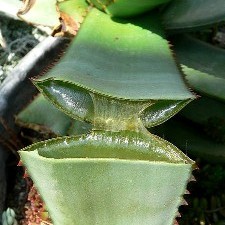
Photo: Wiki User raul654 - Aloe
Rx: "Take Aloes {2 ounces}. Myrrh {1 ounce}. Saffron {1/2 ounce}. Reduce all into a fine Powder, and make them into a Mass with Syrup of Wormwood.
...
These three ingredients are much better reduced into Powder separately, because their Texture are all so different from one another, that they will not do in the Mortar so well together."4
Description: "This claims the famous antient Physician Ruffus [Rufus of Ephesus - 1st century Greek physician] for its Author, who took it from [Greek physician] Paulus Ægineta, Lib. 2. Cap. 26. but with this difference, that they put an equal quantity of Gum Ammoniacum with the Aloes, and had no Saffron. ...but its being intolerably bitter, and nauseous in that form, made the Moderns contrive it very wisely into Pills. ...This is accounted a good Stomach-Purge, and with good reason; for it greatly warms and strengthens it, and but very gently purges. It is peculiarly good in cold Constitutions and Indigestions; and will many times, without other help, cure a Green-Sickness [hyperchromic anemia], in which case it greatly promotes the Menstrual Discharges, and opens Uterine Obstructions. It may be given from {15 grains to 1 dram} but this is not so fit for a Cathartick [laxative] as an Alterative [a medicine that makes changes in the body rather than purge it]; and therefore ought to be given in moderate Doses, and be long continu'd."5
"Pilulæ Russi or Pestilentiales Russi, subscribing to Ruffus their inventour, a famous Physician, and fitting for the pestilence and plague, doe rather prevent infection, then cure the infected: for by reason of the aloes the body is freed from excrements, by myrrha from putritude, and by Saffron the vitall faculties are quickened, but infection once possessed, is not alwayes by such light cordials and gentle laxatives removed, their dose agreeth with that of Pilulæ Aureæ, they are very stomachall, for they refresh much the stomacke, and in any oppressions of the stomacke, where gentle purging is required, they excell."6
1 John Woodall, the surgions mate, 1617, p. 91; 2 John Moyle, The Sea Chirurgeon, 1693, p. 31; 3 "158. John Tweedy's Bill for Medicines. November 8, 1743". Privateering and Piracy in the Colonial Period Illustrative Documents, John Franklin Jameson, ed., p. 459; 4,5 John Quincy, Pharmacopoeia Officinalis & Extemporanea, 1719, p. 422; 6 Woodall, p. 91
Trochisci Albi Rhasis (White Lozenge of Rhasis)
Listed in: Moyle: Troch. Alb. Rhassis1
Category: Compound - Pills and Troches
Humoral Properties: Cool and dry2
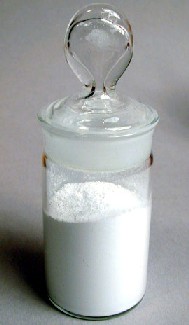
Photo: National Gallery of Art
White Lead
Rx: "Take of Ceruss [white lead - lead carbonate] washed in Rose water ten drams, Sarcocol [gum resin obtained from penaea] two drams, Gum Arabick & Tragacanth, of each one dram, Camphire half a dram, either with Rose water or Womens Milk, make it into Troches according to Art."3
Description: "They are cool without Opium, but cooler with it, as also very drying, and are used in injections, in Ulcers in the yard [penis], and the running of the Reins [kidneys] &c. It seems now the College is very unwilling you should know that they use to contain half a dram of Opium. If there be any Inflammation you may use them with Opium; if not, without: and the manner of using them is this. Take a dram of the Troches, which having beaten them into powder, mix with 2 ounces of the plantane water, and with a Syringe, inject it into the Yard."4
"These were the Contrivance of the Physician whose Name they bear [Persian Muhammad ibn Zakariya al-Razi]: but in the first Dispensatory [Pharmacopoeia?] of the College [of physicians of London] they were directed with half a Dram of Opium, and to be made into Troches with Milk; altho there indeed the Opium is ordered to be omitted at discretion. These are dissolv'd in White-Wine, Rose-water, or any other Liquids to make Collyriums for the Eyes. They assuage Inflammations, and sometimes repel hot corrosive Rheums [running flow from the nose and eyes]. The same are sometimes used for Injections in Gonorrhea's, to cool the Urethra, and defend it against the Corrosions of the gleeting Humours. {2 drams} dissolv'd in {2 ounces} of Liquid, is the usual Proportion of Mixture; and the affected Part to be frequently wash'd with it."5.
1 John Moyle, The Sea Chirurgeon, 1693, p. 33; 2,3,4 Nicholas Culpeper, Pharmacopœia Londinesis, 1720, p. 194; 5 John Quincy, Pharmacopoeia Officinalis & Extemporanea, 1722, p. 446
Trochisci Alhandal (Lozenge of Alhandal)
Listed in: Woodall-Chest: Trochiscus de Alhadall.1
Category: Compound - Pills and Troches
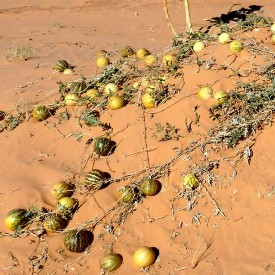
Photo: Ji-Elle - Coloquintes (Citrullus colocynthis)
Rx: "Take of Coloquintida [Citrullus colocynthis] freed from the seed, and cut small, and rubbed with an ounce of Oyl of Roses, then beaten into fine powder ten ounces, Gum Arabick, Tragacanth, Bdellium of each six drams, steep the Gums 3 or four days in a sufficient quantity of Rose water till they be melted, then with the aforesaid Pulp, and part of the said Mucilage, let them be dried in the shadow, then beaten again, and with the rest of the Mucilage, make it up again; dry them and keep them for use."2
Description: "Trochisci Colocynthidos, or Alhandall, as the Arabians speake, doe bring away thicke fleame [phlegm, one of the bodily humors], and all glutinous juices from the braine, nerves, and other more remote parts, they helpe the chollicke proceeding from a glassie tough fleame [phlegm], the Apoplexie [unconsciousness], Squinancie [peritonsillar abscess], falling sicknesse [epilepsy], short breathing, colde and goutie diseases, which scarce give way to common medicaments, and is described by Mesues [8th/9th Assyrian physician Yuhanna ibn Masawaih], the dose is {4 grains}."3
"The Gums seem intended to deaden in some measure the violent Operation of the Colocynth, but considering how little it is used, it is no great matter how it is made."4
1 John Woodall, the surgions mate, 1617, p. 93; 2 Nicholas Culpeper, Pharmacopœia Londinesis, 1720, p. 194; 3 Woodall, p. 93; 4 John Quincy, Pharmacopoeia Officinalis & Extemporanea, 1722, p. 447
Trochisci de Absinthio (Lozenge of Wormwood)
Listed in: Woodall: Trochiscide Absinthio1
Category: Compound - Pills and Troches
Photo: H. Zell - Absinthi Artemisia Absinthium
Rx: "Take of red Roses, Wormwood leaves, Aniseeds of each two drams, juice of Maudlin [Achillea ageratum] made thick, the roots of Asarabacca [Europe wild ginger], Rhubarb, Spicknard, and Smallage seeds, bitter Almonds, Mastich, Mace, of each 1 dram: juice of Succory so much as is sufficient to make it into Troches according to Art."2
Description: "Trochiscide Absintho, or of wormewood (saith Mesues [8th/9th Assyrian physician Yuhanna ibn Masawaih] taketh away the obstructions of the stomake and liver, & intermitting or chronical fevers [malarial fever] sprung thereof, strengthen the bowels, and cause and appetite."3
"Before they [the Royal College of Physicians of London] used the term Absinthium Ponticum, which is a term they gave before bothe to Roman and common Wormwood, ...they it seems either not knowing what Wormwood Mesue [8th/9th Assyrian physician Yuhanna ibn Masawaih] the Author of the Receipt intended, or what Ponticle Wormwood, which before they pratled of, was now quite left out. They strengthen the Stomach exceedingly, opens obstruction, or stoppings of the belly and bowels; strengthen digestion, open the passages of the Liver, and help the yellow Jaundice, and consume watry superfluities of the body: they are somewhat bitter, and seldom taken alone; if your palate affect bitter things, you may take a dram of them in the morning: They cleanse the body of choler [yellow bile, one of the bodily humors], but purge not, or not to any purpose."4
1 John Woodall, the surgions mate, 1617, p. 92; 2 Nicholas Culpeper, Pharmacopœia Londinesis, 1720, p. 193; 3 Woodall, p. 92; 4 Culpeper, p. 193
Trochisci de Minio (Lozenge of Red Lead)
Listed in: Woodall: Trochisci de Minio1
Category: Compound - Pills and Troches

Photo: Wiki User BXXD - Red Lead (Pulverised Lead Oxide)
Rx: "Take of Red Lead, half an ounce; Sublimate of Mercury corrosive, one ounce; Crumb of the finest Bread, four ounces. Make them up with Rose-water into oblong troches."2
Description: "Trochisci demnio, or the Trochis of minium, consume proud flesh [they act as a chemical or potential cautery to destroy flesh that is not growing properly in a wound], mundifieth [cleanses] sordid ulcers, mundifie callous[ed] or hard flesh, and wonderfully cure fistulaes [fistulas - abnormal connections in the body between two spaces]: look more thereof in Johannis de vigo [15th/16th century Italian physician Giovanni da Vigo]."3
1 John Woodall, the surgions mate, 1617, p. 93; 2 William Lewis, The Pharmacopoeia of the Royal College of Physicians and Ediburgh, 4th ed. 1748, p. 197; 7 Woodall, p. 93
Trochisci de Spodio (Lozenge of Ivory)
Listed in: Woodall: Trochisci de Spodio.1
Category: Compound - Pills and TrochesHumoral Property: cool2

Spodium - Ashes
Rx: "Take of red Roses 12 drams, Spodium [ashes of bone or from the inside of a furnace] 10 drams, Sorrel seeds six drams, the seeds of Purslain and Coriander steeped in Vinegar and dried, pulp of Sumach, of each two drams and an half (Maid wind up the Jack [winding up the jack is turning a clockwork-like contraption to turn a spit over a fire - apparently a direction to keep this concoction moving while it heats]) white Starch roasted, Belaustines [pomegranates], Barberries, of each two drams, Gum Arabick roasted dram and an half, with juice of unripe Grapes, make it into Troches."3
Description: "Trochisci despodio, Mesues [8th/9th Assyrian physician Yuhanna ibn Masawaih] have their use in bilious fevers, which bring also a fluxe of the belly, they allay the inflammation of the stomake, liver, and continuall thirst."4
"They are of a fine cooling binding Nature, excellent in Fevers coming of Choler [yellow bile, one of the bodily humors], and especially if they be accompanied with a Loosness [of the bowels], they also quench thirst. You make take half a dram, either by themselves or in any other convenient Medicine."5
1 John Woodall, the surgions mate, 1617, p. 93; 2,3 Nicholas Culpeper, Pharmacopœia Londinesis, 1720, p. 200; 4 Woodall, p. 93; 5 Culpeper, p. 200

